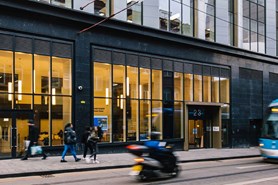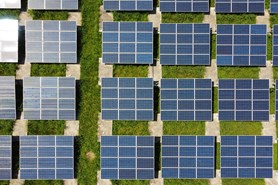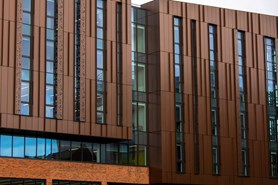Did you know you can liquid cool a data centre with seawater? It’s true, says our data centres and cost management expert Steve Kelly. Solutions like these will actually be integral to solving the sustainability challenge.
There’s a lot, in fact, construction consultancies can bring to the table in terms of solving the expertise gap data centres face, and challenges in other areas like procurement. With nearly two decades’ experience working for major blue-chip clients on data centre schemes around the world, Steve shares the latest outlook on where the pain points now lie for data centre clients.
What’s one of the biggest obstacles right now for data centres?
The speed of it. That’s directly linked to the small pool of contractors on the supply chain who build data centres, particularly in Europe. When you compare the number of data centres in development to the available labour, you start to see the problem. In mainland Europe, there’s a handful of contractors – a stark contrast to the hundreds of contractors who support big blue-chip clients sectors like retail or industrial across Europe.
What’s most important to data centre clients?
The most important thing is for data centres to be built on time. You might think cost matters more, but actually, there’s a data war of trying to outspend each other. Those companies know that as soon as the data centre goes live, the amount of money it makes the client back will dwarf the cost.
You can see this emphasis on building it right reflected in the fact that UK and Irish contractors are the main ones being trusted with delivery, despite the high cost involved in relocating those resources across Europe. It doesn’t mean the clients don’t want to establish a local supply chain of contractors, but that requires education, and education takes time.
What’s the solution to the skills gap?
There will come a point where you can’t have a thousand expats working across Europe because, for one, it’s a huge risk, and financially, it doesn’t make much sense at the end of the day. Our model at Gleeds is predicated on upskilling people locally, which is something we’re doing currently with our team in Poland who are delivering a small data centre.
By imparting our international experience and guidance, we’re making sure that our clients not only have the right skillset but the local expertise too, which is the best of both worlds. It gives them a price point they can buy into, but crucially also upskills the local market. Once you upskill the local market in consultants, the contractors start to follow. If Gleeds in Poland is issuing tenders, that team will expect contractors to comply with what’s required. And it will take time, but it will happen, and that will be driven by consultancies like ourselves.
Can data centres be sustainable? How?
Yes, but fundamental innovation for sustainability in data centres will come when technology advances further. They’ve got the ability to liquid cool servers. What they haven’t got is the ability to do it on a mass scale because it’s far too expensive.
We’re also not escaping the fact that most data centres are built using steel. Steel offers flexibility whereas in-situ concrete provides none whatsoever. And it’s all linked to technology: if a client needs to refit a data centre in 5-7 years’ time because all the servers have changed, for instance, nothing other than steel gives the flexibility to make this change.
There are, however, promising signs for the future sustainability of data centres. All data centres do now stipulate that 80% of steel used has to be recycled (though this does push up cost). Our industry is also getting smarter about where to locate the data centres. Putting them close to the coastline, for instance, brings the massive potential of being able to water cool servers from the sea, which is a hugely sustainable future practice for reducing emissions. Notably, it removes the need for things like air handling units and any other devices or equipment that draw energy. Already, the bigger companies have tested capsules undersea, and the possibility of data satellites in space has also sparked intrigue.
The problem, of course, with these solutions is scale, and the energy needed to put a satellite in space. But there is cause for hope. Ten years ago, the thought of a pocketable 4 terabyte solid state drive seemed inconceivable, yet that’s very much a reality now.
In ten years’ time, I see the construction of data centres becoming a lot more pre-fabricated, modular, and standardised. We’re going to see a large decrease in emissions of data centres as the technology matches the requirements of the world decarbonise.
How will consultancies like Gleeds help innovate progress for data centres?
People have been building server rooms for decades since before computers were built. Conversely, people have been building data centres as we know them now for less than a decade. That is to say, a lot of people who have come into data centres are still learning. One thing that is very nascent in the growth of data centres now is how they procure supply chains, whether it be mechanical and electrical designers, the consultants, contractors, or everybody else.
With big IT companies focused on cloud infrastructure, the software and technology behind it, etc., if you talk to them about construction procurement, most of them won’t have a clue what you’re talking about because building buildings is not what they were set up to do.
So one of the things that can be worked on is the procurement method for data centres as time goes on. A company like Gleeds, which has worked on procurement on some of the biggest projects in the world can help bring that expertise to bear.
There are lots of lessons that can be applied from construction outside the data centres sector. A few years ago, while supporting a major retail company, one of the things causing them a headache was having resurface car parks in all their stores across Europe. This required having to procure a contractor for every car park in each respective local market. So as a proposal, we set up them up with one single contracting team that repaved all the car parks around the continent. It saved them millions of pounds, not to mention time because they weren’t tendering anymore.
That’s just a small example of solving procurement challenges in different ways. And data centres could be exactly the same.

Stephen Kelly
| Director Mission Critical
- steve.kelly@gleeds.pt
- +351 21 1212153




